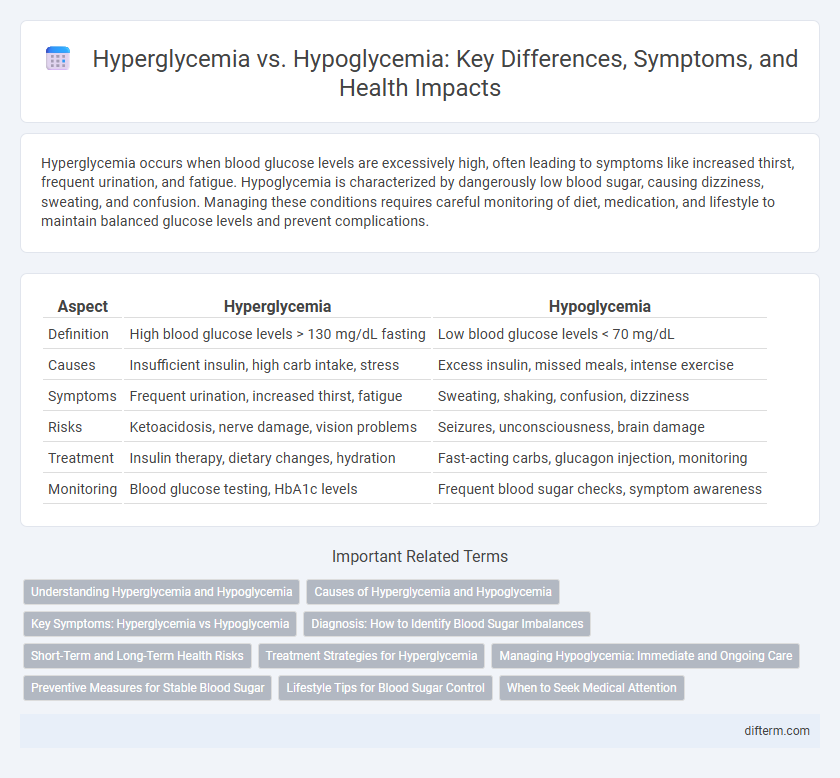Hyperglycemia occurs when blood glucose levels are excessively high, often leading to symptoms like increased thirst, frequent urination, and fatigue. Hypoglycemia is characterized by dangerously low blood sugar, causing dizziness, sweating, and confusion. Managing these conditions requires careful monitoring of diet, medication, and lifestyle to maintain balanced glucose levels and prevent complications.
Table of Comparison
| Aspect | Hyperglycemia | Hypoglycemia |
|---|---|---|
| Definition | High blood glucose levels > 130 mg/dL fasting | Low blood glucose levels < 70 mg/dL |
| Causes | Insufficient insulin, high carb intake, stress | Excess insulin, missed meals, intense exercise |
| Symptoms | Frequent urination, increased thirst, fatigue | Sweating, shaking, confusion, dizziness |
| Risks | Ketoacidosis, nerve damage, vision problems | Seizures, unconsciousness, brain damage |
| Treatment | Insulin therapy, dietary changes, hydration | Fast-acting carbs, glucagon injection, monitoring |
| Monitoring | Blood glucose testing, HbA1c levels | Frequent blood sugar checks, symptom awareness |
Understanding Hyperglycemia and Hypoglycemia
Hyperglycemia and hypoglycemia are critical conditions related to blood glucose imbalances, where hyperglycemia denotes elevated blood sugar levels typically above 130 mg/dL fasting, while hypoglycemia refers to abnormally low glucose levels, generally below 70 mg/dL. Understanding the symptoms of hyperglycemia includes frequent urination, increased thirst, and fatigue, whereas hypoglycemia may cause shakiness, sweating, confusion, and in severe cases, loss of consciousness. Effective management of these conditions involves regular monitoring of blood glucose, adherence to prescribed medication or insulin therapy, and maintaining a balanced diet tailored to individual metabolic needs.
Causes of Hyperglycemia and Hypoglycemia
Hyperglycemia is primarily caused by insufficient insulin production, insulin resistance in type 2 diabetes, or excessive carbohydrate intake leading to elevated blood glucose levels. Hypoglycemia often results from excessive insulin administration, prolonged fasting, vigorous physical activity, or certain medications that increase insulin secretion. Both conditions disrupt normal glucose metabolism, requiring careful monitoring and management to prevent severe complications.
Key Symptoms: Hyperglycemia vs Hypoglycemia
Hyperglycemia presents with key symptoms such as frequent urination, increased thirst, and blurred vision, caused by elevated blood glucose levels. Hypoglycemia, characterized by low blood sugar, manifests through sweating, shakiness, confusion, and rapid heartbeat. Recognizing these distinct symptoms is critical for timely management and prevention of serious complications in diabetic patients.
Diagnosis: How to Identify Blood Sugar Imbalances
Diagnosing hyperglycemia and hypoglycemia relies on precise blood glucose testing, with hyperglycemia identified by fasting blood sugar levels above 130 mg/dL and postprandial levels exceeding 180 mg/dL. Hypoglycemia is diagnosed when blood glucose falls below 70 mg/dL, often confirmed through rapid glucose measurement during symptomatic episodes. Continuous glucose monitors and oral glucose tolerance tests provide additional insights for detecting and distinguishing these critical blood sugar imbalances.
Short-Term and Long-Term Health Risks
Hyperglycemia, characterized by elevated blood glucose levels, can lead to short-term risks such as frequent urination, increased thirst, and blurred vision, while long-term exposure elevates the risk of complications like cardiovascular disease, kidney damage, and neuropathy. Hypoglycemia, marked by low blood sugar, poses immediate dangers including dizziness, confusion, seizures, and loss of consciousness, with recurrent episodes potentially causing cognitive impairments over time. Managing blood glucose within target ranges is critical to minimizing these acute symptoms and preventing chronic health consequences in diabetic patients.
Treatment Strategies for Hyperglycemia
Effective treatment strategies for hyperglycemia prioritize insulin therapy to rapidly reduce elevated blood glucose levels and prevent complications like diabetic ketoacidosis. Complementary approaches include lifestyle modifications such as a balanced diet low in simple sugars, regular physical activity, and close monitoring of blood glucose to adjust treatment promptly. Oral hypoglycemic agents like metformin or sulfonylureas are also commonly prescribed for managing chronic hyperglycemia in type 2 diabetes patients.
Managing Hypoglycemia: Immediate and Ongoing Care
Managing hypoglycemia requires prompt ingestion of fast-acting carbohydrates such as glucose tablets or sugary drinks to rapidly restore blood sugar levels. Continuous monitoring of blood glucose is essential to prevent recurrent episodes and adjust treatment plans accordingly. Long-term care involves dietary management, medication adjustments, and educating patients to recognize early symptoms to avoid severe hypoglycemic events.
Preventive Measures for Stable Blood Sugar
Maintaining stable blood sugar requires regular monitoring of glucose levels and adherence to a balanced diet rich in fiber, lean proteins, and low glycemic index carbohydrates. Incorporating consistent physical activity enhances insulin sensitivity, reducing the risk of hyperglycemia and hypoglycemia episodes. Avoiding excessive sugar intake and managing stress effectively are essential preventive measures to maintain optimal glucose control and prevent blood sugar fluctuations.
Lifestyle Tips for Blood Sugar Control
Maintaining stable blood sugar levels requires balanced meals rich in fiber, lean proteins, and healthy fats to prevent hyperglycemia and hypoglycemia. Regular physical activity enhances insulin sensitivity, helping regulate glucose uptake and reduce blood sugar spikes. Consistent monitoring, hydration, and adequate sleep support optimal metabolic function and blood sugar homeostasis.
When to Seek Medical Attention
Seek immediate medical attention for hyperglycemia if blood glucose levels exceed 180 mg/dL consistently, accompanied by symptoms such as excessive thirst, frequent urination, or confusion, as these may indicate diabetic ketoacidosis. For hypoglycemia, urgent care is necessary when blood sugar drops below 70 mg/dL with symptoms like shakiness, sweating, irritability, or loss of consciousness to prevent seizures or coma. Monitoring blood glucose and recognizing severe symptom onset ensures timely intervention and prevents life-threatening complications.
Hyperglycemia vs Hypoglycemia Infographic

 difterm.com
difterm.com